Text
Maiden in a Tower
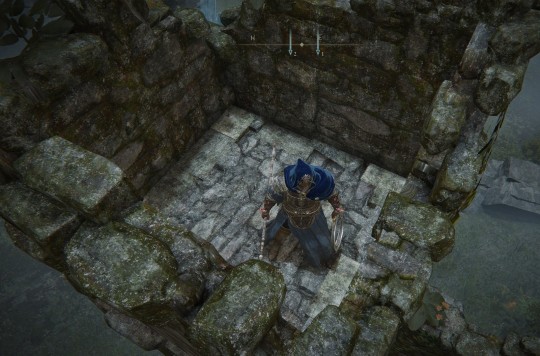
There was an Elden Ring post a while back pointing out how Ranni is playing a trope of the damsel in a tower guarded by a dragon, except that she also commands the dragon. It turns out that the game will in fact allow you to trap yourself in some of the tower tops just outside of Ranni's Rise.
Because you need Torrent to climb the walls and get in but it is not stable ground so you can't summon Torrent to get out if you dismount. You also can't jump out. The only way out of this softlock is to teleport to a site of grace (or, y'know, do something that will deplete the health bar).
From the north of the two towers these are the views of Renna's Rise, Ranni's Rise (directly behind a plant), Mt. Gelmir, the Erdtree, and some nearby crystals on the ground:



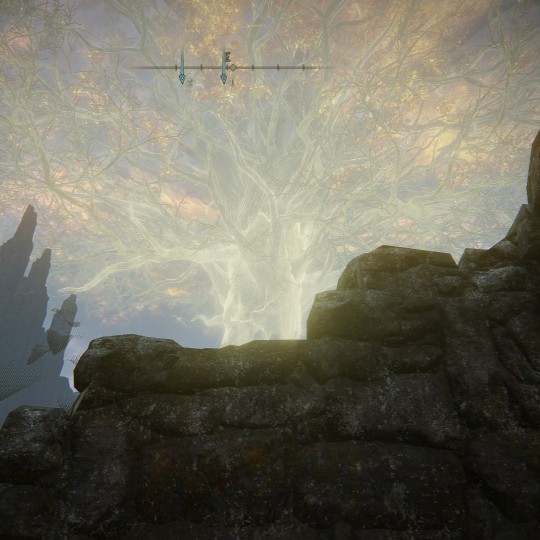


And from the tower approximately centred between the 3 rises we have a gold tree looming overhead to the west (I believe that it is blocking Ranni's Rise from view), and a view of Renna's rise again shrouded in fog, and a gold-leafed tree in front of Caria Manor, and Mt. Gelmir and the Erdtree again (this time the top of the Altus West Divine Tower with Rykard's rune can be seen also).

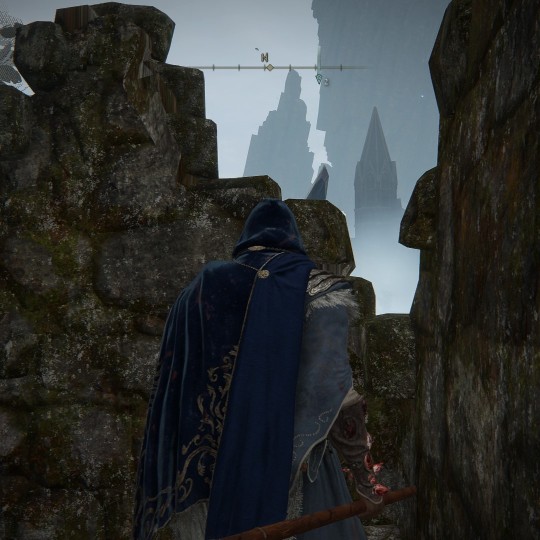

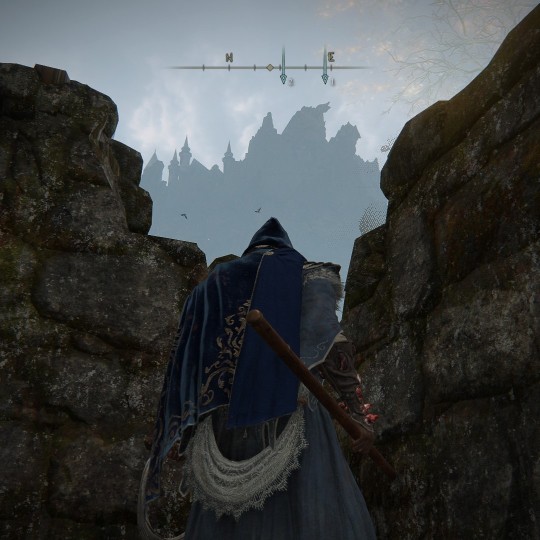
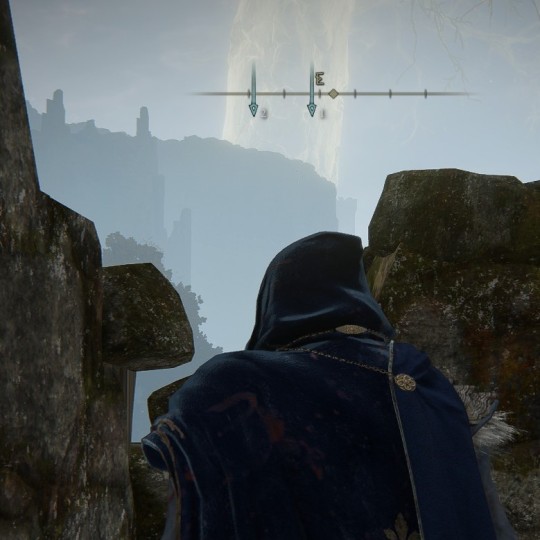
So, yeah. Towers!
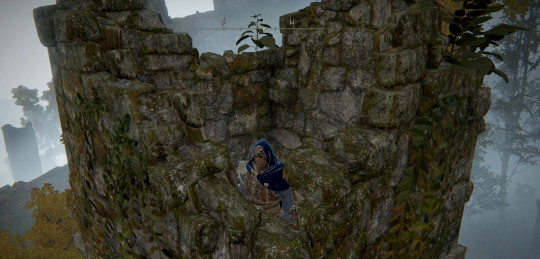
#elden ring#environmental storytelling#I think that I figured out the puzzle of how to read the ruins type structure#Need to do more tests because it's really subtle
2 notes
·
View notes
Text

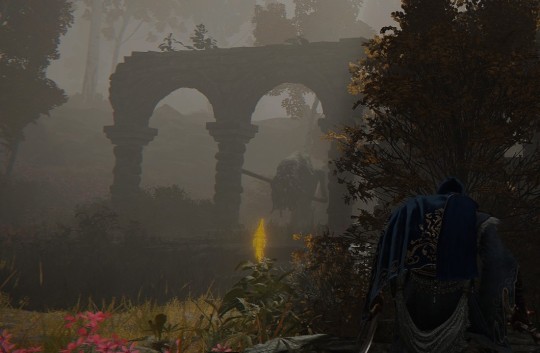
New Elden Ring hobby:
Giving the Wormfaces sites of grace to gather around
#elden ring#environmental storytelling#did you know that “herb-of-grace” is said to kill a basilisk?#seems relevant since both basilisks and wormfaces spread deathblight#note to self: consider photograph potential of placing grace mimics in places#3d perspective tricks
3 notes
·
View notes
Text
For what it's worth, we may have an available timeline marker for the appearance of the Deathblight Omen. Someone recently did a breakdown speculating how the images on the seal in front of the Erdtree can represent a timeline. My additional observation is that the seal can be seen from this location in front of the Withered Erdtree but only partially in a way that the "Erdtree" Icon and above are visible:

To truly make use of this speculation requires cross comparisons of the amount of the seal visible from all other locations in and around Leyndell.
I think that the number of Commoners is also significant. 6 + 1 Omen is mirrored in the 6 thrones for the demigods + Morgott the Omen King.
About those Omen with Cloaks

(I’ve found only two of this enemy variety in the game, if there’s any more of them please tell me because they intrigue me so much)
These specific type of omen are quite a rare find, I’ve only managed to find them in two areas:
Leading a small group of commoners in front of the minor erdtree near the draconic tree sentinel fight in the outer capital

2: Deeply hidden within Azuria Hero’s Grave seemingly guarding the crucible winged talisman

These locations are notably very close to one another, both being a similar distance from the main entrance the Tarnished has to the Capital. The omen in the Hero’s Grave, admittedly, has less implications so I’ll be mostly skipping over him (sorry bud)
Going back to the omen next to the minor erdtree, he’s not the only one in his group with a unique model compared to his enemy type. He is surrounded by commoners (who are normally adorned in a pale cloth) wearing pitch black clothing.

They also don’t throw fire pots like other commoners (think the ones in Fort Haight) Instead, they seem to just be chucking regular stones or maybe a pot with no noticeable elemental damage (I’ll do further testing if needed)
The next question is simple: Why the distinction between models compared to the rest of their enemy variety? The answer to this comes in a few different forms, leading with a fact about the Omen present at the scene: He uses Fia’s Mist.


This is the only spell the Omen uses, all of his other attacks are melee with his cleaver. This leads me to believe that this group not only worships the Prince of Death, but that they have specific associations with Fia herself.
The first thing I wanted to prove is that he was actually using the sorcery and not just spitting it out like basilisks and wormfaces. Luckily for me, the symbol of the Death Sorceries, Godwyn’s half of the Centipede wound, flashes in front of his hand when casted (wasn’t able to get a pic of him casting it sadly)
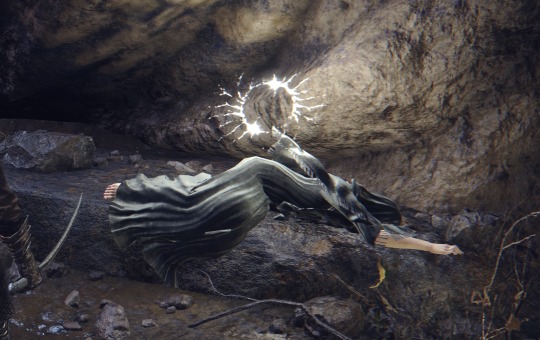
With this Fia association, we can also put the mystery of the unique models to rest. While much dirtier and more withered compared to her clean and soft robes, it seems like these “cult” members are mirroring her appearance. Wether any of these enemies have actually met her in person is a mystery to me. However, if I had to guess, Fia comforting an Omen isn’t entirely out of character for her. She’s always had a soft spot for those oppressed by the golden order. It also wouldn’t be out of character for Fia to gain some allies from a being that has grown to hate the GO for their entire life.
Thus, these omen have pledged allegiance to her cause in some form, and to show this commitment, they adorn themselves with replication of the attire that comforted them
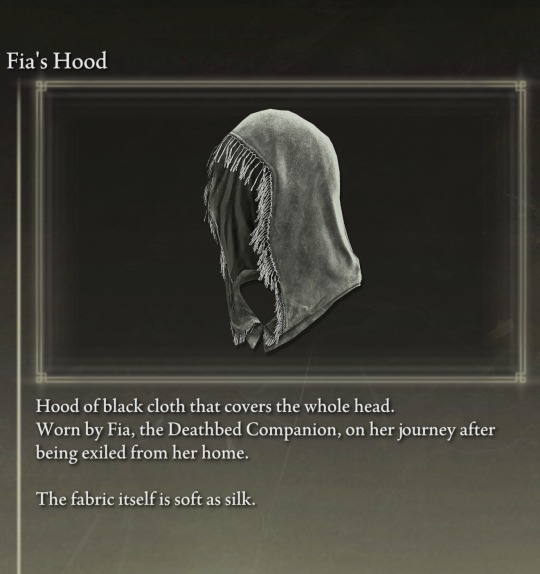
Also notable is the specific tree in which the omen are located. This has been pointed out before in This VaatiVidya vid (along with some of the other stuff mentioned here) is that this Minor Erdtree could possibly be the one that Godwyn himself was buried under.


These two tree’s don’t align perfectly on the map or in world, but their proximity to each other is deeply notable. Maybe there was an intended alignment that was harder to implement due to the locations of the other underground areas, but I’ll bite at the worm anyway that this is supposed to be the same tree. How else could the rotting that is only seen in this tree be explained anywhere else? The trees in the Mountain tops are broken off at the too, but this one is visibly dying in a way unique to itself.
In conclusion (?)
There is a chance that Fia’s worshipping of Godwyn is not only shared by her and TWLID, but by others spurned by the GO and Erdtree. A few Omen found comfort in her and believed that her cause could maybe assist in bringing them back into society as accepted beings. I cannot decide if this possibility is sweet or deeply unsettling.
#Elden ring#elden ring theory#There are a lot of timeline clues hidden in the environment#Good to see connections made that it's only cloaked Omens using this Fia's Mist#Reminds me of the cloaked giant with Frenzy#also because of reasons I think that it is best to look at the seal as a palindrome that works both backwards and forwards#causality and regression
14 notes
·
View notes
Text
Malenia's Waterfowl Dance is called "Dance of the Crane" (Tanz des kranichs) in the German translation text. A similar concept as the heron being associated with blade masters. Long break graceful bird.
Just started The Wheel of Time.
There's a notion of the heron being associated with great swordsmen.
I'm sure that was a concept in Elden Ring?
#Elden ring#Wheel of Time#The golden crane itself is something of a significant motif in WoT. You'll learn by book 2 if you continue reading.
3 notes
·
View notes
Text
I feel like I should make a schedule or something for clearing out my Elden Ring drafts. As an overview of the essays I have in progress:
Key References to Tolkein's Legendarium
Astrological Zodiac and calibration of the FromSoft meta-narrative
The influence of Kuon (2004) on Miquella's storyline
Radagon Anagrams and Word String Theory
Atomic Shells and the discovery of Helium
Literary Parallels to a certain other story that is constructed around Alchemy and Witchcraft
Atomic Decay of Nihonium: a comparison of the spontaneous fission of Dubnium to the 7-step decay chain ending in Californium
Visual references to the Vatican, Rome, and Pompeii
Australia
I also have a tangential analysis of the thematic subtext in .Hack//Sign that's sitting at near complete, but I need to acquire screencaps.
#elden ring#elden ring lore#theory synopsis#my interests are many#I think that maybe this is the preferred order to tackle them in?#The one about atomic decay gets into some sombre topics and I am not sure how to convey them with sensitivity#So does the witchcraft one because it isn't worth doing unless it is to specifically dissect a certain author's terrible conduct
2 notes
·
View notes
Text
and on a related note to that last post, everyone always complains about holy damage being useless, but it's actually really cool storytelling imo. holy damage is decent early on, but becomes very difficult to get through the endgame with. which makes sense, because why would it be easy for you to fight divinity with that same divinity's own power? what reason does the greater will have to make things easy for you?
17 notes
·
View notes
Text
you know i feel like we're all kind of used to the way elden ring's stats work by the time you get this weapon, so it doesn't really stand out, but,
the fact that in order to wield the godslayer's greatsword, you need to level faith, is an extremely metal concept.
#elden ring#elden ring lore#and the sword is locked in a Divine Tower#so either the wielder was overpowered by others stronger in faith with the gods#Or it was abandoned after the realization that gods cannot be killed through faith because they are only as real as they are believed to be
40 notes
·
View notes
Text
The many Anagrams of Radagon
Because I found an anagram generator and felt like applying a little confirmation bias to the results, for fun:
"Adan Gor" - Adan, Thief of Fire is a character in Elden Ring. "Gor" is a dialectical oath variant of "god", with well known uses including Moby Dick ("And, by Gor, none of you has de right to dat whale"). Gor is also Old English meaning "dung". Seems like Adan and Dungeater worship the same sun god.
"a dog ran" "a god ran" - the dog part is self explanatory as Radagon is described as a leal hound and here we see that Radagon was a dog god who fled.
"rand oga" - "rand" and "oga" are both Old English/proto-Germanic meaning altogether "on the edge of terror". As blacksmith Hewg says of Marika (who is Radagon): "The sheer terror of her…". In the deep FromSoft history, there was once a minor miner NPC character in King's Field (1994) called "Rand Ferrer" whose name means "on the edge of a blacksmith".
"A Dragon" - I think that the Elden Beast is a fine example of a sparkle dragon. The dragon is also a symbol of the never-ending cycle of alchemy, as both prime materia and the end product. The dragon is endlessly splitting into brother and sister parts and recombining into the divine hermaphrodite - so says Carl Jung in CW12 "Psychology and Alchemy". And the connection that I make personally is that the red-haired Rand al'Thor as the 'Dragon Reborn' is the main character of the Wheel of Time books (1990-2013). See above usage of 'Rand Ferrer''.
"naga d'or" - "naga" is Hindu meaning "a member of a race of spirits recognized in Hinduism and Buddhism that have mingled superhuman and serpent qualities, are genii of waters and rain, and live in a subaqueous kingdom", and "d'or" is French meaning "of gold". Elden Beast seems to exist in a plane of endless water and is a creature of the Golden Elden Ring.
"Ra Dagon" - "Ra" Egyptian god of the sun and "Dagon" the principal deity of the ancient Middle Euphrates region. Also the Lovecraftian Dagon fish god thing.
"Ra Gonad" - Ra is god of all of the sky (and earth and underworld), not just the sun. Venus was born of the testicles of Uranus - god of the sky - thrown into the sea. The second phase of Malenia's fight is styled as an allusion to Botticelli's "The Birth of Venus". So technically this one can work with Radagon as a link between his own father the old god of the sky and/or sun and his daughter Malenia.
"Agro DNA" - from the slang term "agro" meaning "aggressive". Perhaps that Radagon has an aggressive nature in his genes. He is something of a Beast.
"Argo DNA" - Argo was the ship sailed by Jason to find the Golden Fleece. Note the golden sheep in the Altus Plateau area of Elden Ring. It is also the name of a gigantic constellation that was split into three parts in the modern day - thus Radagon's lineage is found in the stars. Afterall "It is said that long ago, the Greater Will sent a golden star bearing a beast into the Lands Between, which would later become the Elden Ring".
"Ag Ra don" "Ag adorn" - "Ag" is chemical short form for Silver, so "Ra dressed in silver", I suppose. More alchemy stuff. One must recall that "Radagon" seems not to have been needed as an entity until going to Liurnia to confront a house of the moon (traditionally associated with silver). Also "Ag" derives from the French "Argent" and another major use of French that I've noted is in the name of "Seluvis" forming "se lu vis" meaning (probably with broken grammar) "To read one's own face".
"Argon AD" - "In the Year of our Lord, 18" - Argon was isolated in 1894 by William Ramsay ("Will I Am, Ram Say" - see Golden fleece above). It is element 18 on the periodic table and has a lavender/violet glow when placed in an electrical field. Notable event in the year 18: "Winter – Germanicus Caesar arrives in Syria, as new commander-in-chief for the Roman East."
"ad argon" - "Ad" is a Latin modifier as in the case of "ad absurdum" or "to the point of absurdity" and etc (much like this post!). "Argon" is a Greek word meaning "lazy" or "inactive". Overall perhaps stretches to "to the point of stagnation"
Edit: found another one. "D Aragon" which could be spun into character 'D, Hunter of Death' based on 'Dominican Nicholas Eymericus', who was the Inquisitor General of Aragon and in 1376 associated Alchemists with Magicians "because they cannot possibly achieve their aims without the assistance of demons".
#Elden Ring#linguistics#elden ring lore#Learning about the periodic table of the elements is one of my new favourite things#Also I just searched up “dog” and “god” out of curiosity and I'm side-eying Xolotl really hard now#Dog with sword in mouth where have I seen that before in a dog associated with Radagon
5 notes
·
View notes
Text
Loki as inspiration for Radagon
I have seen it many times where people are able to interpret Marika as having attributes connected to Odin - trickster, hung on a tree and stabbed with a spear, dropped an eye (scarseal) down a well - but less often do I see identified Marika/Radagon's thematic ties to other Norse gods and especially Loki.
From review of the literature Radagon alone is something of an amalgamation of many myths and stories: Loki, Illmarinen/Kullervo, Orion, Xolotl, Gollum/Smeagol, the Rebis and/or a literal interpretation of man and woman becoming "one flesh" as described in Genesis in Christian bibles (and a handful of others). All under the combined names of gods Ra and Dagon. It may even be appropriate to think of him as a mimic on a meta level, given all of these inspirations pulled together.
And of all of those inspiration one stands out as especially synergistic with a mimic character - Loki the Trickster and shapeshifter. Maybe it's a pop culture recency bias of people getting hung up on the hair colour, since the Marvel black hair version of Loki is its own thing while most scholarship on the matter has Loki as either red-haired or (more likely) blonde. But specifically the version of Loki that appears in Wagner's Ring Cycle in the mid-1800's is red haired because Loki is conflated with the fire giant 'Logi' for that production. And on the other hand it also makes some sense to associate Radagon with the explicitly red-haired Thor who wields a hammer (more on that later).
Anyways, the main point is the characteristics of Loki that apply directly and indirectly around Radagon:
Half giant heritage. Radagon hates his hair the colour of fire giants - this one is clear.
Shapeshifter who has had children in male and female form. Radagon has fathered children and Marika has been mother to children. The 8-legged horse Sleipnir does not make an appearance but perhaps a spiritual analogue does: the Royal Revenants are 8-limbed. Godfrey is described as "scion of the Golden Bough" and a scion is a limb taken from a tree, so perhaps it is meant to be that in the empty space of the narrative Marika was mother to 8 children of the Golden Lineage.
Had three children with a giantess: Hela the queen of the underworld who is half dead and half alive (Ranni), Jormungandr the World Serpent (Rykard), and Fenris Wolf who has the most convoluted mythology of the 3 but is most known for having a voracious appetite (Radahn eats corpses and howls at the sky). The twist on the classic here is that none of the three were born into these roles and instead all grew into them.
Loki wagered his head in a bet with a craftsman who forged 3 treasures: a ring for Odin that generates 8 copies of itself every 9 days, a golden boar for Freyr, and Thor's hammer Mjolnir. Again, two of the treasures have direct parallels in the Elden Ring and Marika's Hammer. The third is less obvious but there are indeed boars in the Lands Between. And now a man riding boar in the Shadow of the Erdtree trailer. When he lost the bet the craftsman had planned to behead him, but Loki pointed out that he had not wagered his neck, so instead the craftsman sewed his mouth shut. My main point is that the Preceptor's Mask associated with Radagon's journey to Liurnia has the mouth "sewn shut", and Glintstone crowns in general have associations with beheading.
Was imprisoned for his role in tricking Hodr - the blind Norse god of darkness - into killing Baldr - Norse god of light. Parallel to the death of Godwyn. This has led as least some people to match up Ranni to Loki, which itself is not incorrect because this is an original story and not a 1:1 recreation of myth. But to the theory that Marika/Radagon orchestrated the Night of Black Knives, this is a point in favour.
Is credited in the Prose Edda with inventing the fishing net (same pattern as Radagon's rune). This also connects to an incident just before Loki was caught where he takes the form of a salmon and the gods use his own net to help catch him (Radagon's rune blocking entry to the Erdtree). However, there is another connection to Ranni here as it is said in the more reliable Poetic Edda that Loki actually borrowed the net from Rán, goddess of the sea.
Obtained from craftsmen a wig of golden hair for Sif - wife of Thor - to replace the hair he cut off for a trick by shaving her bald. This one is not explicitly invoked - aside from the tendency for demigods to be shorn of their hair and have it included in their helms. It is more an exercise of extrapolation after identifying a pattern with other Loki stories and also drawing upon that imagery of Radagon wielding Thor's hammer. Imagine Radagon divesting himself of his red hair and replacing it with golden hair as part of becoming Marika as a preferred identity. Sif also was known to wear a veil in the time before receiving new hair - and Marika wears a veil in her church statues. The statue of a bald monk appears to be symbolic of the beginning of Marika's Age of the Erdtree.
Altogether, the point is that there are many ways to understand what it means that Radagon and Marika are the same person. Mythology is one of those ways - so often in myths identities are fluid because they represent a set of stories that drifted in retellings and were later brought back and merged into a single entity by selectively choosing the new canon. The two aspects of a single god are interpreted as two different gods due to language barriers, wander apart for a bit as the stories diverge when told by different storytellers, and merge back together or get subsumed into the identity of another god entirely.
Edit: As pointed out in the reblog, scholarship speculates that Loki originated as a disguise of Odin as Trickster God. However - to nip in the bud a conclusion that could be made from this - I would not say that this indicates that Marika started as a genderswapped Odin who diverged to become a Radagon Loki. Because FromSoft has stated explicitly who most embodies Odin: Gideon Ofnir. Ófnir is a name meaning "Inciter" and attributed to Odin by Snorri. Gideon synergizes well as a Tarnished version of Radagon - representing a previous version of him from a certain point in time. If you like, consider Gideon to be a companion who joined Radagon on the campaign to Raya Lucaria - he had to make an acquaintance of Seluvis at some point after all. Gideon claims to know that Marika wishes the Tarnished to struggle forever, which places him on the same line of thought as Radagon's eternal agonized hammering of the ring (and Gideon's weapon is a type of hammer as well). Radagon has been noted to use only incantations in his fight despite having spent time learning sorcery at Raya Lucaria. These traits of combining incantations and sorcery are instead displayed by Gideon who gives payoff to the characterization of Odin as wizard.
I stick to my original assessment of what it means that "Radagon is Marika" and Radagon is both Marika's other self and yet to become her. Marika is a persona constructed by Radagon in imitation of someone else, and an identity assumed through shapeshifting. He tried to disappear completely behind the persona of Marika to cover his flaws but could not do so because she was a hollow imitation and repressing the core issues instead of confronting them only caused them to fester. It's like the theme of God of War Ragnarok (2022) as in the Detail Diatribe by Overly Sarcastic Productions: generational trauma is the Hidden Hand of Fate. When those festering doubts resurface Radagon as Loki as an offshoot of Odin tries to solve the problem like an Odin: by tortuously hanging on a tree for knowledge, plucking out eyes to drop down wells, and so on. That's the generational trauma bit - it's a cycle of pain. It's why it was important for Ranni to shed her bloodline connection to Radagon in the context of the narrative. And then slay the Hidden Hand of Fate (I.e. Manus Celes). It frees her from the cycle and from continuing the mess of complexes that was Radagon/Marika. She is the queen of the underworld that is represented by the Lands Between and she is doing it on her own terms.
#Elden ring#Elden ring lore#Literary analysis#I guess my choice to write an essay about Loki in highschool is paying dividends#I want to mention how the Raptor's Feathers cloak may point to the story of Loki borrowing Freya's cloak of falcon feathers#But I think that is better addressed in discussing other noted Trickster characters Patches and Domhnall of Zena
3 notes
·
View notes
Text
Light and Shadow in Leyndell
The movement of shadows in Leyndell is quite noticeable throughout the day. I speculate that this can be used as a timeline indicator.

The thinking is this: Morning is the earliest point in the historical record. Different parts of the city are illuminated from Morning to Early Day to Late Day to Evening. By tracking the amount of illumination on certain landmarks it could give an idea of when they had their "time in the sun" (the moment when these things were the centre of attention).
There are some specific examples that seemingly support this possibility. As I understand it, other sources indicate that the Fortified Manor in Leyndell is associated with the transition of power from Serosh to Godfrey, and that both pre-date Radagon's rise in status, and that the Effigy of the Martyr is associated with Marika being punished in the Erdtree for the Shattering. Here are some matching observations of how the patterns of shadows operate in the area of the West Capital Rampart site of grace:
1. The Beast Crest on the Fortified Manor is only illuminated in light from Morning until the end of Early Day



2. The Radagon Statue is only illuminated from the beginning of Early Day to end of Late Day. Also he sits in the bowl :D
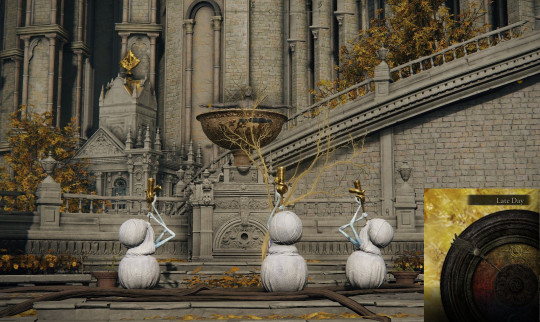
3. I believe that the Effigy of the Martyr in this area is only illuminated for a thin slice of time in the Evening
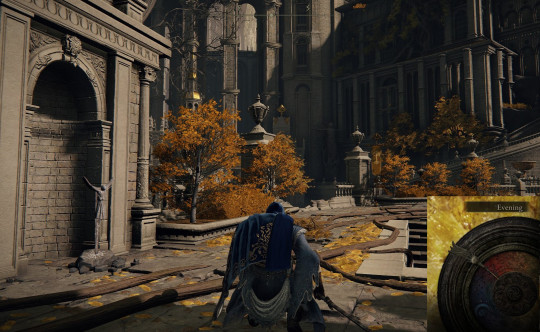
If this pattern is correct, then it should be possible to map many other setpieces in the open areas of the city in time as well as in space.
For example, the golem "playing dead" at the Divine Bridge is in sunlight at least partially in the Morning, then in shadow when the sun is at its peak and then illuminated from Early Day and onwards - although with its head in shadow.

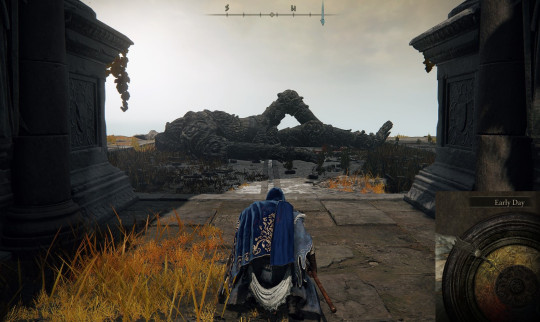

I would also generally expect that the shadows have some significance for corpses out in the open. Perhaps the moment that they are covered in shadow indicates the moment of their death. That is what I infer from this corpse holding a Stormhawk Axe in the Courtyard of the Fortified Manor, which has the shadows creep over it just as Late Day begins (the same time that the Beast Crest is also being covered by shadow!).


And I guess there are probably some areas that are never illuminated at any time of day.
#Elden Ring#environmental storytelling#3d perspective tricks#analysis of art design#Noticed the good shadows in that spot when I spent like 20 minutes doing chip damage to the Gargoyle and running away#There's an entirely second thing in Leyndell with the bolt of Gransax which should probably be cross referenced with the shadows
4 notes
·
View notes
Text
I think that it is useful to think of it as building on themes from Demon's Souls.
In Demon's Souls there is a prison in a place called the Tower Latria. The area boss for the first of three levels ("The Prison of Hope" - as named in the remake) is called the Fool's Idol - a four armed copy made in the image of the lost Queen of the land.
Original Demon's Souls (2009)

Demon's Souls (2020):

Relevant source text:
Soul Ray
"Magic from the soul of the Demon Fool's Idol
Shoots off a light which pierces the target
The idol was in the form of the queen of now-lost Latria
This magic shows part of the power of the queen, who was also a gifted sorceress."
Former Royal's Wife Dialogue
"The Queen banished her depraved old husband from the land.
He returned in strange golden garb with foul Demons in tow.
They pillaged great Latria, land of the learned, and locked us in this dungeon.
Since then, they've been feeding off our souls…
Telling us over and over that if we go above, we will be granted redemption."
The second level is called "Upper Latria" and its end boss is bipedal chimera creature called "Maneater", which is under the command of the husband with the golden garb. He is the "Old Monk" and is the end boss of the third level - "The Ivory Tower" (sortof - he's wrapped in a yellow cloth which is the actual boss that takes the form of a tornado-like funnel shape and controls another person to do the fighting). These are themes that have come up a few times in FromSoft's other games between Demon's Souls and Elden Ring.
But also there is Kalika or Kali Mata, the dark mother, goddess of time, change, creation, power, destruction and death in Shaktism since it was codified around 400-600 CE. She was first mentioned as early as 1200 BC as the "black tongue" of the seven firey tongues of the god Agni. She is depicted wearing severed heads and arms and with long wild hair (and standing on Shiva) like this:

Also Kali's abode is the Cremation Grounds. There's an odd piece of convergence here as element 19 on the periodic table is represented by the letter "K" for Kalium, but it is actually derived from the Arabic "Qali" meaning "ashes". The English name is similar "Potassium" derived from "pot ash" because this was the earliest form the element was isolated in.
One of the reasons that this is interesting is that "Kalium" burns purple in flame tests:


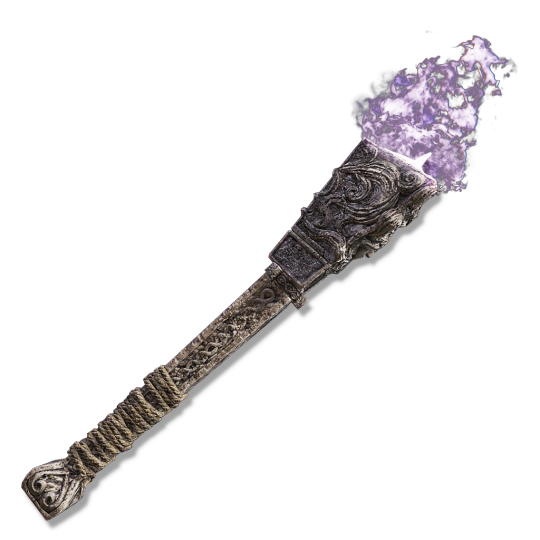
So, all that is to imply that Ranni's mentor the snow witch was a manifestation of Kali and a spiritual successor to the Queen of Latria and/or Fool's Idol. And the worldbuilding involving four-armed Wraith-Callers and Puppets is tied up in bringing together these themes in-universe.
Anyone got any theories on why the Carians are associated with having four arms ? all the Carian nobles we see in Liurna have four arms, the puppets have four arms, Ranni has four arms, that is kinda weird
#elden ring#analysis of art design#The soulslore wiki also speculates that the Queen belonged to a Yormendar royal family#also black flame is a real thing (or something of an optical illusion)#It is observed by burning sodium in the presence of a sodium lamp light
16 notes
·
View notes
Text

Hazily recounting an Elden Ring Archaeology video I watched
5 notes
·
View notes
Text
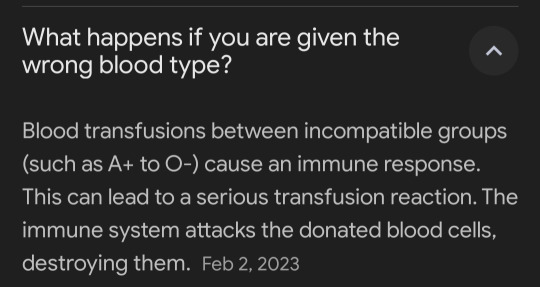
Uh oh
Why Miquella take a Nap in the Roots
Bro has anemia from bleeding all over the Haligtree. He's low on iron and it makes him sleepy.
#elden ring#Also fun story#My dad has the rare O- universal donor blood type#We'd say “the vampires are calling!” whenever Canadian Blood Services would call asking for blood donation
13 notes
·
View notes
Text
Why Miquella take a Nap in the Roots
Bro has anemia from bleeding all over the Haligtree. He's low on iron and it makes him sleepy.
#elden ring#theory synopsis#Not really I'm just suffering fatigue again#Need to get my vitamin C vitamin D and iron levels figured out I guess
13 notes
·
View notes
Text
The Dark Souls Pendant

A simple pendant with no effect. Even so, pleasant memories are crucial to survival on arduous journeys.
I have been looking up the 12 year old discourse over the Dark Souls Pendant item.
People like to bring it up as an example of Miyazaki "trolling" by saying he'd pick a useless item as a starting gift. With evidence being in a later interview saying that was "a bit of an intention to play a prank". I agree that there is a prank happening here, but it took all of 15 minutes for me to read a few wiki pages and think of at least four reasons why Miyazaki would pick the pendant as a starting gift. So. I will go through them.
1) Questline Importance
To draw attention to the nature of hollows, and perhaps generally incentivize people to look at questlines holistically in considering the fail states to be as significant as the successes. There is an NPC in the game named Rhea who drops the pendant item if her quest terminates early by being slain by another NPC - Petrus. If her quest is progressed further to the Duke's Archives (crystal dragon library) she turns hollow and instead upon death only drops her Ivory Talisman - no Pendant. The Ivory Talisman is an interesting thing of itself to be obtained at the end of this quest, considering that its name translates to "the false dreams of the greatness of man" (poet Virgil wrote of receiving false dreams by passing through the gates of ivory, and "talis" is Latin for "so great"). But regardless, turning hollow = loss of the pendant = loss of pleasant memories.
2) For Trade Value
a.k.a. Affiliation with the Blade of the Dark Moon covenant. The Pendant may be traded to the invisible crow "Snuggly" who desires things that are soft and warm. In return, the player receives the Souvenir of Reprisal that is used to increase rank in the Dark Moon covenant. This item has the form of "a blood drained shrunken ear". Some sources say that this use for the pendant was not available at launch and only patched in later, but regardless as the director Miyazaki would have known that this trade is intended. And perhaps this is the extent of the prank - he knew for a fact that the "functionality" of the item literally did not exist but what it does have are its trade value and its lore value.
3) Rejection of the Dark Moon Covenant
The Dark Moon Covenant is unlocked by finding a plain gold coloured ring called the Darkmoon Seance Ring and equipping it to speak with secret endgame boss Gwyndolin behind a fog wall. If you ever cross the fog wall to see Gwyndolin you get kicked out of the covenant. Members of this covenant use the blue eye orb to invade other players who have committed PVE or PVP "sins", where the names of players who have done and their sin level are written in the Book of the Guilty. Altogether quite convoluted. Originally, before the launch of Dark Souls Miyazaki said that he would choose the pendant or "nothing". I imagine because he is not a game character who needs an item to recall pleasant memories - he is a person who keeps his memories in his head. And similarly the Souvenir of Reprisal would be a reprisal on a meta level. Something of a warning against being so willing to trade away happy memories in the service of an intangible entity. Weigh and measure what it costs to devote hours to hunting achievements and secrets and high ranks in video games compared to anything else that you could be doing or thinking about.
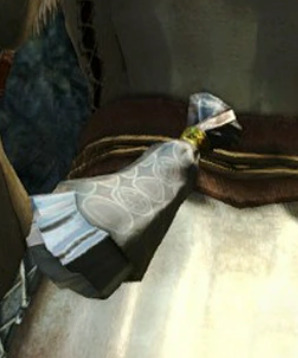


4) Foreshadowing
This is also sortof a combination of points 2 and 3. As mentioned, the Souvenir of Reprisal is in the form of a severed ear. And I can't help but notice that Sir Gideon Ofnir's illustration at the start of Elden Ring shows him lying in a bed of severed ears. Ofnir being a name for Odin, who famously has two ravens named "Thought" and "Memory". Considering that the pendant is representative of memory there are some pieces that can be put together here. Also, wiggling at the corner of my mind are the opening lines of Shakespeare's Julius Caesar: "Friends, Romans, countrymen, lend me your ears;. I come to bury Caesar, not to praise him." Speaking of foreshadowing, put a pin in that for later - it might become relevant when discussing the significance of the Rubicon River and the longest year in the history of the Roman calendar.
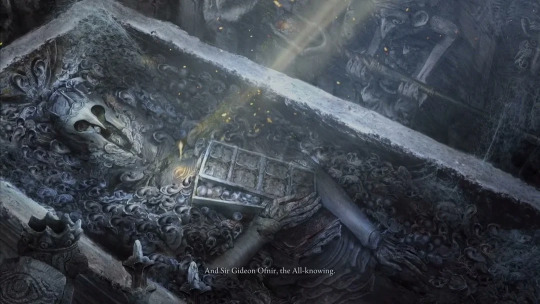
But then there is also the Dark Moon covenant, which comes back in Elden Ring in connection to Ranni. It is in the lore snippets that Ranni was affiliated with the Dark Moon, but this is perhaps no longer the case - I find it more likely that she left the Dark Moon behind in Chelona Rise and now merely adopts the aesthetic. She never does use the spell that has her name attached to it. There is no dark moon covenant in Elden Ring - or any covenants - because FromSoft does not care any more to stoke player incentive to grief others or to have a group of players dedicated to griefing the "rulebreakers". People are more than happy to deliver unpleasant memories to other people for free.
So for the people who would accept nothing less than the Pendant being a mechanical key that opens a secret door - they are missing the point of the "trolling". Instead of making a pleasant memory out of exploration and appreciating the artistic work for what it is, they have chosen to make it a negative memory of the time they pushed all of the buttons in a Skinner box and nothing happened. And memetically convey this experience upon other people. Placing external blame on an internal inability to cope with trial and failure to receive a reward that was never actually promised. It is indeed a failure to internalize that basically every time Dark Souls - and Miyazaki himself - "pranks" its players it is to teach a lesson about the themes of the game underlying the lore.
(Also, the Pendant does have a legitimate use in the Dark Souls boardgame. The Pendant image is attached to the "Heroic Action" token that is flipped to indicate usage of the special abilities of each class. The boardgame was designed and released multiple years after the video game, but would have passed approvals with FromSoft, for what it's worth.)
#Dark Souls#Case in point: I got “pranked” by the Capra demon fight too many times and turned off the game#Elden Ring is right there and is a much friendlier place to learn whatever I'd need to actually play through Dark Souls#If I feel like it someday#Because Capra Demon and his two hunting dogs is representative of Orion and oh boy does that come back over and over in FromSoft games#FromSoftware metanarrative#I'm half expecting that pendant = “penned ant” was intentionally spun into the use of ants as enemies in Elden Ring
3 notes
·
View notes
Text
Elden Ring: Miyazaki's Undiscovered Element
Here's my pitch: puzzle type #3 from The Witness (2016)
The first type of puzzle in The Witness is the one that the game is marketed for - a series of line puzzles on panels. The second type I won't spoil here. The third type is otherwise known as "perspective easter eggs". I am at this point reasonably certain that this is the so-called "last secret" of Elden Ring, or at least part of it.

Firstly, to clear things up Miyazaki did not say that there was "one last secret" - that was a clickbait title invented by articles a few degrees removed from the original interview. The quote as presented in the IGN article is as follows:
“For me personally, there is a small element that I feel has not yet been discovered. So, whether that’s up to user interpretation or up to just further investigation and playing, that’s something I’m looking forward to....I think it’s a question of when and not if, but there may be something small still missing.”
Points of Comparison with The Witness: Forced Perspective
Here are some examples of what these perspective tricks look like in the Witness:

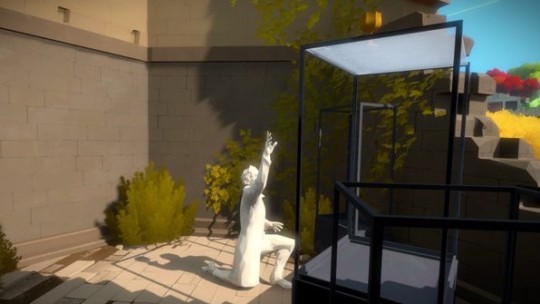


The statue in the foreground and the one far away on the mountain appear to be reaching for each other. The petrified man reaches for a gold chalice forever out of reach, but his shadow already holds the cup. A pair of wings is hung up in a window frame and you can pose your character in front. A small twig stands in front of a window and only from inside the building does it have a canopy made of cloud.
I have noticed similar set pieces in the environments of Elden Ring:


But here is where I think that Elden Ring diverges from the Witness. Simply finding these satisfying setpieces is half of the work, and the other half is puzzling over the meaning of the perspective, in the context of place and time.
Going through Castle Morne and thinking on what is in the field of view while standing in front of the wooden artillery boards with the metal wing decals. For example, there is a chamber to the left upon entering Castle Morne with no items or enemies inside it. Across from the entrance there is one of these boards. And looking into the little room from the perspective of a person desiring wings, you can see the significant thing about the room: two of the fire spewing dragon shaped flamethrowers that are not used at Castle Morne but are in use at Stormveil. Further examining the room, this is a manufacturing workshop for them.
The bald man cultivating one bud from a crucible producing many sunflower buds is menaced by a shadowy figure emerging from the firey Mt. Gelmir. Is there more to be observed with this one? Probably, as this set of figures occurs several times in sequence and the column with spear-holding figure appears in various states of repair. Something that I have noted is that there is a spike in complexity of these types of observations upon reaching Altus Plateau.
Another Elden Ring Innovation: Visions of Collectible Items
But let's say you are unconvinced about any particular meaning behind lining up a nice photograph at any statue. Here are some examples of scenes built around using items in the environment that can be interacted with:

Heading east of the Abandoned Coffin site of grace and up the hillside there is a place on the right-hand side just near the cliff with 1 carriage stacked on 2 others. At the top corner there is a purple soul item - which is a nascent butterfly. The camera can be angled so that it looks like the soul of the broken golem on the ground below.
Of other uses of nascent butterflies, there's the collapsing cliff at the Chapel of Anticipation - the goal is so close yet out of reach. There's a Wormface in the area under the bridge where Gold Mask first appears that is sobbing in front of a pool of water filled with gold fireflies and slugs, and directly across the pool from the Wormface there is a group of Nascent Butterflies.

And involving Scorched Butterflies: in the small Kaiden Mercenary encampment in Limgrave one of them is sitting and sleeping in front of the fire. Sneaking up and standing directly on top of the Herba behind him, there appears to be a soul item emerging from the stack of fire kindling on the left. The Scorched Butterflies here do not remain over the fire, but instead drift between fire and kindling. The item is actually obtained from a corpse behind the firewood and is the Armorer's Cookbook [1] that allows crafting of Fire Grease and Fireproof Dried Liver.

There is another notable place on the beach in Limgrave looking north where a Kaiden Raider seems to grieve over a corpse in its funeral pyre. A soul item "white flesh" emerges from the corpse, while Scorched Butterflies seem to rise above the flames and towards the Chapel of Anticipation in the distance. From standing at the location of the corpse, the sun sets beyond a rotten boat sitting on the shore.
The Last Sights of Dead Men: Iterating on Dark Souls
"There were once heroes who walked the battlefields, abundantly blessed by the Erdtree itself, who upon earning their honor simply died." - Hero's Rune
It is not uncommon to find corpses simply lying out in the open in many places in Elden Ring and holding "soul" items - by which I mean that they resemble the design of souls in the Dark Souls games. Some of these are unique weapons or key items, and some hold something more mundane like a handful of Stormhawk feathers. What were they looking at when they died? What are they running towards or away from? Standing on top of them, is there anything in the surrounding landscape that is perfectly aligned with another thing in a way that seems deliberate? Items in this game represent concepts - what insights did these dead men reach that caused them and the items they hold to be abandoned by the Greater Will and simply die in place?


In the Weeping Peninsula there is a group of 4 angry jellyfish standing around 3 chairs with 2 corpses on the beach to east of Castle Morne. Looking towards the Weeping Peninsula Minor Erdtree with back against the middle chair (corpse holding Arteria Leaf), there is a visual illusion with the cliffside and wall turret that makes it look to be sitting in a little pot (this is the image used at the top of the post). This draws some connection between the genesis of the Erdtree and pots - a crucible is a type of pot. What is this little scene saying about the Crucible era? Another prominent feature here is that Morne Moangrave is visible, but the tree behind it does not become visible until walking far enough south on the cliff to coincide with two dark jellyfish on the lower beach becoming visible.

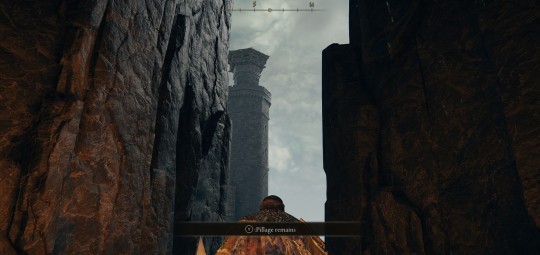

Behind Castle Morne there is a corpse lying in a crevasse which is posed with a bag over its head and being eaten by two crabs. The corpse holds 15 Fire Arrows and is looking directly towards a tower with a flammable 6-sided wooden structure at the tower top. There is also a small cut out in the cliff to allow clear sightline towards a single jellyfish which is very small beside the tall tower.


In the room in Stormveil where Nepheli Loux stands over the corpse of the Banished Knight, as you stand in the doorway the position where she's standing is right over his…codpiece. However, looking from the perspective of the corpse in the corner on the right she appears to be emerging from his head, like Athena from the head of Zeus.

From the vantage point of the corpse looking over the cliff behind the Church of Vows the Raya Lucaria Debate Parlour is haloed by the Liurnia South Erdtree. Things aligning with Minor Erdtrees from particular marked locations is a not uncommon observation. This corpse holds 8 Stormhawk feathers - can corpses be found with other quantities of feathers and strung together to show a sequence of travel? Is there a pattern in general behind sets of corpses that hold various quantities of common material items? One thing that this does imply is that there is a connection between the Liurnia South Erdtree and Radagon's arrival at Raya Lucaria, even though it is separated by distance from the Church.
Many Small Things that are Easily Overlooked
Essentially, for any static item found in the environment that can be picked up into the inventory there will be one or more notable observations in the landscape. I mean everything. Sites of grace. Rebirth monuments. Mushrooms. Rowa fruit. There are noticeable patterns where some tree or rock or other structure will be very deliberately placed in alignment or obscuring distant landmarks while standing at these locations marked by game mechanic objects. Landmarks such as the Erdtree, Divine Towers, the Minor Erdtrees, the Moon, and the Giant's Forge are common to take note of since they are so prominent, but any structure can be significant.
To show how finely tuned this can be - in this example Ranni's Rise is obscured when standing directly on top of the mushroom. Standing a metre to the right and the tower is again visible:


If nothing else, pausing to look around at these item points helps build an awareness that at many key locations on the map one or more divine towers will be in alignment with the Erdtree. This is quite possibly the only means of getting answers about what is the purpose of the divine towers - I'm guessing that they represent the influence of the Great Runes that they hold. Depending on which combinations of Erdtrees and towers are visible from the specifically marked points in the landscape it shows that the near location is in the domain of the distant landmark.
For example, the Liurnia Divine Tower is directly in front of the Erdtree from the Rebirth Monument at Laskyar Ruins, and 3 other divine towers are also visible from this location:
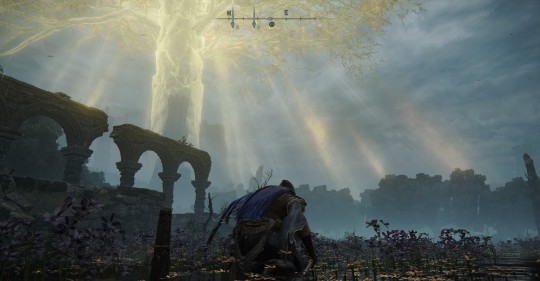
The types of common observations do depend on type of item. Patterns emerge that from the viewpoint standing on top of mushrooms there are distant landmarks very deliberately blocked by adjacent trees. Rowa Fruit Bushes are often found in pairs and there are subtle changes from comparing the two perspectives. Sometimes at Trina's Lilies it's more about what landmarks are blocked from sight until moving far enough away from them that it exceeds the draw distance of the item - as if the lilies are in hiding.
As with enemy difficulty, the environmental observations have scaling difficulty depending on the region of the map. Limgrave and the Weeping Peninsula seem to function as something of a tutorial zone for the Rowa Fruit Bushes especially. Liurnia has a lot more going on with the mushrooms and the time of day and visibility of the moon and sun are important. Altus Plateau does much longer sequences of tree alignment observations (starting from mushrooms), and keep an eye on the number of visible segments on the bolt of Gransax from any given location in Leyndell.
Why do I think that this is connected to the missing element?
I have seen a number of discussions popping up in the past few weeks of people noticing something that they have never noticed before and declaring that the "secret" is found. It's often something like an artwork detail or line of text that in retrospect has connection to the DLC. This is not special - I think we will find that a lot of things already in-game are connected to the DLC because - y'know - it's still the same game and the DLC is revealing a buried history that FromSoft always knew was there. I'm happy for people being more observant, but again it's a very limited interpretation of what a "missing element" or "something small still missing" could be.
And then there is the other part of the argument that Miyazaki is just trolling and saying that there is something small missing - when there is no possible way for him to have followed every discussion on what people have and have not seen.
But consider this: I am suggesting that there is an entire element of intended gameplay that is not being used. If people were serious about hunting for clues in the environment of the type that I have described there should be videos about it! Secret hunting streams, compilation videos, whatever. Articles with top 10 quirky photos you can take. I can happily run around for hours sneaking past all enemies and trying to observe them unnoticed from various angles like a virtual wildlife photographer.
And what I have shown is just the most aesthetically pleasing findings and "easy" spots to draw conclusions about. Think about how many corpses and how many items there are to interact with in the environment. Thousands. There is so much.
#Elden ring#environmental storytelling#3d perspective tricks#there is visual poetry everywhere#There's so much to interpret and I would like anyone else to please start looking
3 notes
·
View notes
Text
Wheel of Time and Elden Ring: an examination of parallel themes
As I mentioned some months ago, I felt a strange sense of connection between the themes of Elden Ring and the Wheel of Time. I know that other people get similar vibes relating to Lord of the Rings and the various works of George RR Martin - also valid. But what I want to unpack are the points of comparison between the Breaking and the Shattering, the Lord of Chaos and the Lord of Frenzy Flame, and the Shadow and...the Shadow.
Extensive spoilers ahead for both works, but I generally assume that any potential reader has played Elden Ring and has not read Wheel of Time, for purposes of adding context.
The Breaking
In the Wheel of Time, the Breaking of the World happened as a result of men falling to madness. Magic in this setting is called the One Power and is split into male and female halves, and it was only the men who set the seven seals on the Dark One's prison, so only men received the backlash. And people who channel the One Power tend to live extended lifespans, so for hundreds of years the landscape was torn apart by wild magic and civilization generally fell from a near-utopian society to a post-post apocalyptic world scattered about with relics and ruins of the high magical past. More than this, the male half of the One Power was afflicted by the Taint, which for the next 3000 years would drive to madness all future generations of men who used it.
In broad strokes this is similar to the opening narration of Elden Ring. The Ring was shattered and the taint of madness infected the demigods, resulting in a landscape shattered by warfare.
The Lord of Chaos
A few men were spared from the type of random madness associated with the taint. However, they did this by binding their fortunes to the Dark One, which is arguably an entirely deeper degree of insanity.
The 13 Forsaken are a group of men and women strong in the One Power who turned away from the Light to serve the Dark One and the Shadow. Twelve of them think that if they help the Dark One win, then they get to divide up the world and rule it in the aftermath. What they don't seem to consider is that that the Dark One - known as Father of Lies, Sightblinder, Shai'Tan, etc - is letting them believe what they want to believe.
In the Wheel of Time, the Dark One only has power so long as humans are willing to act as it's agents. It doesn't matter what all of the other Forsaken think they will get out of serving the Dark One - the most favoured of all of them is Ishamael, who is quite clear that his goal is to break the wheel and end the world. Because he wants this, the Dark One gives him power, and because he has power he is able to take steps to achieve this goal, in a feedback loop. When the Dark One says "Let the Lord of Chaos rule" at the start of book six, it's a general enough statement that the other Forsaken are willing to go along with it - it benefits them to overthrow the ruling class because they think they will eventually get positions of power. They are all deceiving themselves. Unlike Ishamael, they can't comprehend that their role in causing chaos and putting more stress on main character Rand al'Thor - the Dragon Reborn - is all towards the goal of getting the Dragon to the point of despair where he will end the world. In a line of dialogue that is easy to take metaphorically instead of literally, it is said that "the Land is One with the Dragon". To be a Lord is to impose some kind of Order - but chaos and order are opposites.
So the Lord of Chaos is no Lord at all and as Melina says "the Lord of Frenzied Flame is no Lord at all". Shabriri and Ishamael are quite similar for what they represent. Shabriri is an agent of the Three Fingers in the same way that Ishamael is working with the Dark One. They even have the body snatching thing in common (and that does also come up in the prologue of WoT book six - also titled 'Lord of Chaos' - with two of the Forsaken being placed in new bodies that were simply the first 2 that happened to be available).
So, when Shabriri says "may chaos take the world" it's not so different from "Let the Lord of Chaos rule". When we think of chaos we think of random unpredictable things continuing to happen and life continuing to exist. When Shabriri speaks of chaos, in the short term there will be chaos in the world…but the real goal is that the world burns up followed by nothingness. Heat death of the universe. The player is in the same role as Rand in this scenario. Shabriri can't destroy the world himself - he tells whatever tales he needs to convince the player to become the Lord of Frenzy Flame and destroy it all for him.
The Shadow
It was relatively recently revealed that the Shadow of the Erdtree would be taking place in the 'Shadowlands', and confirmed that Miquella has travelled to this land. The exact nature of the Shadowlands is not yet revealed, but based on past information surrounding Miquella it is hinted at being a Dreamland. This section is something of an exploration of the way that 'The Shadow' and 'The World of Dreams' are interconnected in the Wheel of Time.
The World of Dreams in the Wheel of Time is mainly the domain of dreamwalkers. It is a reflection of the waking world, only it's eerily empty of people and the sky contains a field of 'stars' representing the dreams of other people. The dreamwalkers go there to meet each other when their physical bodies are separated by long distances, or to enter the dreams of non-dreamwalkers to send information through dreams, or to gather information by scouting the landscape using fast travel methods.
And there's an entity in The Wheel of Time that serves as the series antagonist and is most commonly known as 'The Dark One'. This entity has no physical form. It sometimes uses a humanoid avatar. But mostly The Dark One works through proxies and the sum total of its followers are called 'The Shadow'. The Dark One was imprisoned by the Creator at the moment of creation. Notably there are no religious schisms in the Wheel of Time as we'd understand them. There is not really any doubt about the existence of the Creator or the Dark One, just disagreement over what level of influence the Dark One has at any given time.
The backstory of the series as revealed in book 4 is of a past utopian society that was striving to reach greater heights. They were not satisfied with the One Power being split into gendered male and female halves and so the researchers drilled a hole into what they thought would be a new power source, but what they later realized was the Dark One's prison that had been set by the Creator. This was the inciting incident for the Breaking of the World.
Where these two concepts intersect is that it is strongly implied that the Dark One's Prison was itself the World of Dreams. The influence of the Dark One is expressed through random occurrences of dream logic happening in the waking world, the Dark One's domain is an anomaly that is equally as deadly in both the waking world and the dream world, the lead researcher who drilled the hole in the prison prides herself on being the best dream walker among the Forsaken, and so on. The Shadow operates on dream logic.
And it makes sense why so many powerful and otherwise intelligent people as the Forsaken turned to the Shadow. They were enchanted by the fantasy of living their dreams and they became numbed to the damage done to the people and Land around them. People would not be people if we did not have dreams - this is why the Shadow can only ever be sealed and not destroyed - but abandoning all responsibility in favour of living out personal dreams is not a sustainable way of life in the grand scheme of things.
#Elden ring#The Wheel of Time#media analysis#It is a struggle not to go off on a tangent#About how Elden Ring psychologically profiles it's players based on which of the 6 endings provides the fantasy that appeals to them
1 note
·
View note